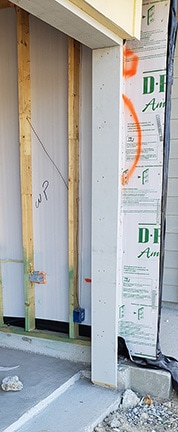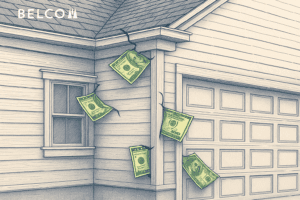Estimated reading time: 8 minutes
The garage door jamb is an easily over-looked trim piece that really should get more attention. Garage door jambs are the trim pieces that cover the rough framed opening for your garage door.
It is also referred to as garage door liner or garage wrap.
The main purpose is to cover the rough framing and provide a mounting location for the garage door seal. Due to the location and the wear and tear needed it is best to go with a sturdy option.
Think about what goes in and out of your garage; probably a car or two, maybe a boat, your lawncare equipment and maybe your kid’s sports gear.
What happens when you or your spouse rubs a mirror against the garage wrap while backing out? Or, rubs the boat trailer fender or wakeboard tower against it backing the boat in?
You probably do not want to think about fixing the garage on top of fixing the car or the boat. For these reasons we are going to dive into which trim material is the best choice to line your garage door opening.
Real Wood Trim For Garage Door Jambs
We will start with natural wood choices and work our way down the list: We are looking for strength, stiffness, durability, rot resistance, and appearance.
Additionally, I look for fastening ability, and paint performance in the material to use for a garage door jamb.
I’ll break down real wood trim into three categories: (1)general construction lumber, (2)cedar and redwood and (3)primed white wood.
General Construction Lumber
General construction lumber, primarily 2×6 or 2×8, are often used to cover the garage door opening for wood framed construction.
Many times, the installation is performed by the framing sub-contractor as part of the framing service. However, the garage door jamb in well-built homes are more than just part of the framing. It is part of the trim, appearance, and curb appeal to the home.
The garage door jambs need some of the qualities found in framing lumber, such as strength and stiffness. But raw framing lumber such as Douglas Fir or Southern Yellow Pine are not appearance graded, or naturally decay resistant.
Priming needs to be done in the field for best paint performance too. For these reasons, general framing lumber is capable but a poor performer in several categories.
Cedar & Redwood for Garage Door Jambs
Selecting cedar or redwood makes an excellent garage door jamb material.
Cedar and redwood are naturally decay resistant, and have enough stiffness to perform well in this application.
Builders have been using it in proximity to wet areas for years where rot is possible with favorable results. Cedar typically lasts much longer than most other trims, yet that is not to say it will never rot.
The legs of the door jamb material typically remain in good shape, even if they do absorb some water and swell from time to time. Cedar will always return back to normal size once dried.
It is also available in a length structure from 10’-20’ .
Therefore, waste is minimal compared to OSB based products.
The one real downside to cedar is the cost. It is by far the most expensive garage door jamb wood material. Cedar Averages 20% above fiber cement and 40% above primed white wood.
Cedar and Redwood are great materials, but they are budget-busters.
Primed White Wood
Primed white wood (PWW) on the other hand is a very budget-friendly material choice.
In most cases it is the least expensive option. Certainly, it is a great choice for production builders and anyone on a budget.
Be sure to use appearance-graded material to achieve the best look.
To start with, PWW is offered in 10’ and 20’ length structure so again, waste is minimal. Also, all standard single or dual bay garage doors can have a single pieced header without a seam.
Just like cedar, when PWW absorbs water it will swell a bit, but unlike OSB based trims, it shrinks back to its normal size.
Because it is primed the edges hold topcoat paint well.
The 2×6 or 2×8 PWW material face allows garage door jamb material and the house trim to blend well.
The real concern with standard PWW is its tendency to rot faster than other woods used on the exterior of a home. The primer adds a measure of water resistance but does not offer rot resistance to the wood fiber.
What you need is preservative treated primed white wood.
Preservative Treated & Primed White Wood
Building with preservative treated primed white wood takes care of the rot complaint and more.
Preservative treated Belco XT® Trim protects the wood fiber itself and the factory primer offers an even coat of water resistance.
With Belco XT® Trim you have no worries about rot, mold, or mildew because the wood fiber is preservative treated on raw wood.
Preservative treated Belco XT® Trim is also coated with an industry leading primer. This primer offering incredible adhesion properties for the top coat in addition to an appearance grade wood look.
So even when the neighbor kid drags the lawnmower across it, chances are the paint will stay put.
However, even if bare wood is exposed, the treatment will keep the board from decaying either way. Belco XT® trim is the ultimate choice for garage door jamb material. Overall, well priced and features that offer enduring performance.
Fiber Cement
Fiber cement trim has made a name for itself in the siding industry for a few reasons. The leading reason is it won’t rot.
It is free of natural appearance defects found in general construction lumber. And, perhaps most importantly it stays stable in most environments.
Sure, it is pretty durable once it’s installed, but it can be pretty brittle during the install process causing increased material cost.
The more years fiber cement trim has been on the market, the more sizes and thicknesses have become available. That includes garage door wrap material which is typically made out of 5/4×8 or 2×8.
The fiber cement version is only available in 1” or 5/4” thicknesses for this application.
Either would work fine since they are directly attached to the 2×6 framing. You need to take care when using fiber cement in this application to limit impact damage.
So, fiber cement in most conditions will be strong enough to be a suitable garage door wrap. Due to its cementitious nature, the ends jamb legs can be closer to concrete than any wood product per the manufacturer’s recommendations.
Issues With Fiber Cement As Garage Door Jambs
The two main drawbacks to fiber cement are the length structure, and the strength to withstand impacts.
Fiber cement jamb material is 12’ long which means you have a 33% waste factor for each door leg. You are wasting almost as much material as you are using!
Now for the header, on a single garage bay the 12’ will cover, but again will leave you with a 2’-4’ scrap. Therefore, this means that for the average single bay garage door you have to buy three pieces that come out to 36 lineal feet of material and then throw away 12’ or one whole piece-that’s crazy!
On the other hand, a 12’ stick of fiber cement isn’t long enough to install as a seamless header in a double door application.
For this application, the length structure is less than optimal. Chances are the garage wrap will probably win the battle of the mirror that got too close, but a fender or blade deck on the mower most likely will cause a chip or crack.
Once it’s chipped there really isn’t a good way to repair it.
If it cracks, aside from filling the crack with caulk and painting, the best option is to replace it all together.
Neither are great options. Overall, I would recommend sticking with fiber cement siding but look elsewhere for trim.
OSB trim products for Garage Door Jambs
OSB trim products solve some of the length structure issues that fiber cement brings to the table. But they also bring their own drawbacks.
Let start with the positives of OSB based trim. The biggest upside to OSB based trim products is the 16’ length structure which leads to minimal waste.
For example, an 8’ high door with one 16’ board can be cut in half to make both garaged door jamb legs with zero waste.
Also, on a 7’ door the waste is still minimal.
The 16’ long material can work well in terms of the standard double garage door. One 16’ long board for the header can be pieced better for wider double doors.
A cleaner look is always better than multiple small pieces.
Main Issues With OSB Garage Door Jambs
Now that we’ve seen the way OSB trim products solve the fiber cement drawbacks, let’s look at the main issue it brings.
The only issue with OSB based trim products are the porous edges, and for the garage door liner that’s the main concern as well.
For starters, the edge of the garage door jamb liner is exposed all the way around to the weather. Which leaves a porous butt end tightly to a woodgrain embossed face at the top of the jamb. This isn’t the best look to begin with.
Then factor in that the embossed face covers with paint really well, and the porous backside sucks it up like a sponge. Again, not the best look.
The real concern is the porous ends on the legs because they are in very close proximity to the garage floor and driveway. Inevitably, this means the ends will be repeatedly exposed to water.
Know that the OSB trim products have much more resins added the chance of the legs rotting out is slim.
However, there is still an excellent chance that they will swell as water is absorbed. Not only are the swollen bottoms of the legs visually unappealing, but they are also more susceptible to damage from being rubbed by tires, or lawnmowers, etc.
And once swollen, OSB does NOT return to it’s original shape.
OSB based trim may solve some issues with a better length structure than fiber cement but not without drawbacks of its own.

Additional Comments
“As a professional door company, we install garage doors almost every day. Installing a fancy new door on beat up door framing just looks incomplete. Taking the time to trim out your door opening properly will truly make the difference.”
–Matt Bruso of Four Seasons Garage Doors in Virginia Beach – Four Seasons maintains an A rating with the Better Business Bureau of Hampton Roads and was created to bring honesty, integrity, and affordability to each and every customer.












